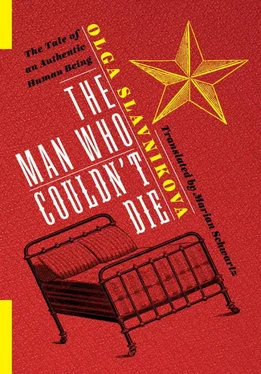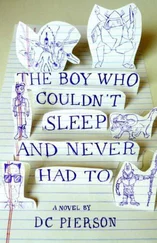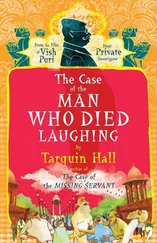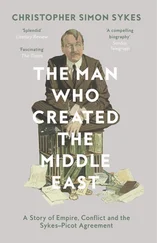Another motif associated with his wartime glory is the huge, gilded German bed that he brought home as a trophy and upon which he lies for the fourteen years of his paralysis. We learn that on this luxurious bed, Alexei also repeatedly raped his wife, Nina. The motif of rape in connection with the German bed serves to point at the unnamed by Slavnikova, but well-known to the Western reader, rampage of sexual violence during the Red Army’s victorious raid across Germany at the end of World War II.
It turns out that the authenticity of Alexei Afanasievich’s postwar experience is also quite questionable: “In all the decades of their life together, the Kharitonovs had never reminisced about anything together. They hadn’t accrued any symbolic property in common, such as any love, however brief, immediately tries to acquire.”
Eventually, Slavnikova’s analytical gaze reveals that the old scout’s authenticity has only one real foundation—his association with death: “There was something odd and even sinister to Alexei Afanasievich’s abnormal longevity.” A continuing reversal of meaning between life and death, blurring the distinction between these states, permeates the entire novel. Death is present not only in Alexei Afanasievich’s wartime past but also in his ice-cold family life after the war, and of course, in his present half-dead condition. A thick web of motifs associated with death surrounds this character, just as themes of sleepwalking surround Nina and themes of emptiness—Marina:
He was already a failed product of death, a defective good from whom death had taken a step back without dispensing with the continuity of life in his illuminated consciousness. The veteran had not reconciled himself to this and was now planning to make death by his own hand—to repeat the mirror image of what he had done to others with such ease.
Husband and wife had tacitly admitted the possibility of death and its legitimate proximity. After this chaste barrier fell between the Kharitonov spouses, death for Nina Alexandrovna and Alexei Afanasievich became something much less shameful than their clumsy nighttime lovemaking, no hint of which had been permitted during the sensible daytime hours.
The similarity between death and sexuality in these passages is not a Freudian slip of the writer’s pen. Rather, this is the true meaning of nostalgia for “Soviet authenticity,” of the post-Soviet attraction to “Soviet glory”—it elevates death as the only authentic truth, the supreme social and individual value. In short, nostalgia is self-destructive, as the novel’s plot vividly demonstrates.
The interweaving of motifs associated with the novel’s characters as well as with the satirical representation of hidden electoral mechanisms produces a surreal effect that transforms Slavnikova’s seemingly realistic close-ups into a parade of monsters. Her text is inhabited by people who look like smaller copies of themselves, foreheads covered with natural wooden patterns, faces reminiscent of minerals: “His large face was made up of parts that looked sanded, without any wrinkles whatsoever, and between these broad patches of youth lay winding darknesses that also looked sanded, darknesses that retained the professor’s age, like soil in the cracks of a polished stone.” These transformations of the human into the nonhuman are coupled with opposite metamorphoses, when objects act like living beings. Consider “an awful old leather bag sewn from scraps that looked like a creation of Dr. Frankenstein’s…She’d hoped that the shapeless monster, to which she would never entrust even the smallest denomination of currency, would digest everything she didn’t want to remember during her tense daily labors and especially at night.” Or “the heavy bus, which kept dropping on its ass,” or the “shuddering elevator, whose buttons had turned into black ulcers long ago,” or the door, “which had occasionally dropped rusted-through wallpaper nails, like rotten teeth.” These monstrous creatures are the embodiment of ressentiment; they visibly materialize what is brewing inside people and inside the country. They manifest phantasms that occupy reality, taking control of time and space.
However, these spectacular metamorphoses add a supplementary dimension to The Man Who Couldn’t Die . Despite their depressing direct meaning, all these metaphors fill the novel’s style with wit, playfulness, and joyful estrangements. They establish tangible connections between Slavnikova’s novel and great literary predecessors—not only Bulgakov but also Andrei Bely, Dostoevsky, and Gogol. Through these links, Slavnikova situates post-Soviet ressentiment within a long (and wonderful) tradition of the Russian grotesque. This purely artistic twist offers a different perspective that overcomes the phantoms of the given time and suggests examples of productive distancing from contagious illusions shared by the majority.
Nietzsche argued that ressentiment “itself turns creative and gives birth to values.” [3] Friedrich Nietzsche, On the Genealogy of Morality , ed Keith Ansell-Pearson, trans. Carol Diethe (Cambridge: Cambridge University Press, 2002), 21.
The Man Who Couldn’t Die shows exactly what kind of creativity and values the post-Soviet ressentiment gave birth to. Hopelessness and cynicism, a readiness to deceive and a willingness to be deceived, the valorization of death over life and of the past over the present (and future)—taken together they constitute the soil on which the aggressive nationalism and jingoism of the 2010s would breed. The art of distancing appears to be another value born out of ressentiment, and it offers a productive alternative, both intellectually and aesthetically, as Slavnikova’s novel dazzlingly demonstrates.
Olga Slavnikova has a very serious view of literature, comparing it with the hard, fundamental sciences and treasuring its complexity of vision above popularity. She says in an interview:
In my understanding, literature as an art form requires the same attitude as fundamental science. The uninitiated may find it incomprehensible. But one fundamental work of a mathematician, which, in the best-case scenario, only a thousand like-minded scholars understand, can completely change the picture of the world. [4] Iuliia Rakhaeva, “Olga Slavnikova: ‘Dialog idet mezhdu pisatelem i mirozdaniem, a chitatel’ lish’ prisutstvuet,’” Druzhba narodov 6 (2009), http://magazines.russ.ru/druzhba/2009/6/ra15.html .
Obviously, this is her ambition as a writer. The Man Who Couldn’t Die accomplishes this maximalist program. The novel will stick in your mind like a splinter. It is as discomfiting as it is invigorating and provocative, yet its multifarious effects can change the picture of contemporary Russia by shaking numerous stereotypes and, at the very least, by eliding sweeping generalizations and oversimplifications about its past, present, and future.
World War II veteran Alexei Afanasievich Kharitonov had been lying in the farthest and probably coziest corner of their standard-issue two-room apartment, immured in his enfeebled, emasculated body, for fourteen years. “A very good heart, a very strong heart,” Evgenia Markovna, the aging district doctor, who looked like nothing so much as a wise rat, murmured. Every month, her slender, wide-set legs took her to this apartment and this corner, where the paralyzed man was spread out under a blanket, on top of a fresh, tightly stretched sheet, wearing new, haphazardly pulled-on underpants with elastic like a machine-gun belt. “Just like a young man’s,” the educated old woman murmured as she ran a cracked sliver of cheap soap under the faucet while the veteran’s wife, the young pensioner Nina Alexandrovna, held a terrycloth towel worn to patches from laundering at the ready. Both women tacitly understood that talking about his heart was no explanation.
Читать дальше












